The Charles and Joanna Coinage of Mexico City, 1536-1571
by Cori Sedwick Downing
Not long after the Conquest of Mexico by Hernan Cortes in 1519, the exploitation of Mexico’s mineral wealth demanded the need for a mint. After ten years of petitioning, the Spanish crown finally issued a royal decree authorizing a mint in 1535 and sent the Castilian nobleman Antonio de Mendoza there to become the first viceroy in the Americas and to open the mint in Mexico City, where he requisitioned Cortes’ home for the purpose. Minting began in early 1536 using the designs and denominations outlined in the same royal decree, which stated that ¼- and ½-real coins would comprise a quarter of the production, 2- and 3-reales coins another quarter, and 1-real coins the remaining half. The 1-, 2-, and 3-reales coins would have castles and lions with a pomegranate on one side and two columns with the inscription PLVS VLTRA (“More Beyond”) on the other. The ½-real pieces would have a K (for KAROLVS or Charles, Joanna’s son and co-regent) and I (for IOHANNA or Joanna) on the other. The legend on all pieces would read KAROLVS ET IOHANA REGES HISPANIE ET INDIARVM, or whatever part of that would fit. The pillars side would bear an M, the mintmark for Mexico City. The rest of the design was left up to the first workers at the mint. Copper coins (2 and 4 maravedís) were also struck from 1542 to 1551 using similar designs.
Numismatists have come to call these coins “Charles and Joanna coins,” and have divided them into two major periods using names proposed by NesmithRobert I. Nesmith, The Coinage of the First Mint of the Americas at Mexico City 1536-1572, NNM No. 131, American Numismatic Society, New York, 1934: available in USMexNA online library over sixty years ago—“Early Series” coins (from 1536 to 1542) and “Late Series” coins (from 1542 to 1571) — based on substantial design changes in 1542 when all-new dies from Spain arrived. The first dies of the Early Series bore Gothic lettering, but the die-punches wore out fast and were replaced by cruder, New World-made punches that tended toward Latin lettering (as Nesmith said, the number of dies must have been enormous). These die changes enable us to follow the evolution of the Early Series coinage. When the new-design dies came in 1542, however, the Early Series dies were discarded and the Gothic lettering was gone for good.
Kent Ponterio spent the time to ascertain the correct order of assayers, something that a predecessor, another great researcher, Robert Nesmith, was not able to do. Nesmith, however, wrote the bible on these coins, The Coinage of the First Mint of the Americas at Mexico City, 1536-1572, in 1955 and we still use his book extensively today, until an updated reference comes along.
One of our main references is the so-called Tello de SandovalFrancisco Tello de Sandoval was a Spanish ecclesiastic and statesman during the reigns of Charles V and Philip II. He was born in Seville around 1508, the son of Juan or García Gutiérrez-Tello de Sandoval, and Beatriz Barba Marmolejo, both belonging to important Sevillian families On 8 August 1528 he obtained a scholarship to study at the Colegio Mayor de San Bartolomé of the University of Salamanca He was a doctoral canon of the Cathedral of Seville, inquisitor of Toledo and a member of the Council of the Indies from 16 June 1543.
On 13 May 1543, Emperor Charles V issued him the first of two decrees in which he entrusted him with the visitation of the Viceroyalty of New Spain and the Royal Audiencia of Mexico, in charge of putting into effect the New Laws in these territories and of attending to the charges that were made against the Viceroy, Antonio de Mendoza y Pacheco, who would become his main rival. He carried out this visitation from his arrival in America in 1544 until his departure in 1547, and in it he was granted additional powers of a judge of residence. On 18 July 1543, he was also appointed Inquisitor of New Spain by Cardinal Tavera, Archbishop of Toledo and Inquisitor General of the kingdom.
Tello de Sandoval encountered fierce opposition from Viceroy Mendoza, and gave up his position after the appointment of Luis Hurtado de Mendoza, the third Count of Tendilla and elder brother of the Viceroy, as President of the Council of the Indies on 23 July 1546. His visitation is especially known for the implementation of the New Laws, the prohibition of slavery for the Indians, and the avoidance in New Spain of a rebellion like the one that occurred in Peru with the implementation of these laws. His reports were essential for the Recopilación de las Leyes de las Indias,, published in 1570.
After the conflict with Viceroy Mendoza, Tello de Sandoval returned to court in September 1547. He was forbidden to present his reports to the Council of the Indies, and between 1550 and 1555 rulings were filed prohibiting him from bringing cases against the Viceroy and other members of the powerful House of Mendoza. However, he continued to serve in his position as counselor of the Indies, being among the signatories of the constitution of the Royal and Pontifical University of Mexico in 1551.
After the death of Emperor Charles V and the accession of his son, Philip II, Tello de Sandoval was appointed president of the Royal Chancery of Granada, a position he held between 1557 and 1559, the year in which he was promoted to the presidency of the Royal Chancery of Valladolid. In 1564, King Philip II promoted him again to the presidency of the Council of the Indies, commissioning him with a radical reform of the government of the Indies. He held office from 1565 to 1567. His office was hampered by his failing health, as well as the opposition of some of his former supporters, who accused him of excessive thoroughness and inefficiency in carrying out the necessary reforms. After obtaining the appointment of bishop of Osma on 25 April 1567, he resigned the presidency of the Council of the Indies and all his political posts.
After twelve years at Osma he reluctantly received a promotion to the bishopric of Plasencia in 1578. He died on 8 July 1580. investigation that took place between 1545 and 1547. It was an investigation to determine whether there was any malfeasance at the mint, so names of mint workers and assayers were mentioned along with some dates of their offices.
Coin Design
A royal decree from Spain in 1535 gave guidelines for creating coins to the Viceroy, Antonio de Mendoza, who was the former treasurer of the Granada mint, and the first assayer, Francisco del Rincón, whose father had worked at the Toledo mint and whose brother also worked at the Mexico City mint and went on to become the first assayer at the Lima mint. An earlier decree in 1497 established some standards at the Spanish mints that carried over to Mexico. For example, an assayer’s mark should appear on coins so everyone would know that he was responsible for each coin’s weight and fineness.
Production at Mexico City began in the spring of 1536 with punches from Spain that included Gothic lettering. The decree stated that ¼ and ½ reales coins would comprise a quarter of the production, 2 and 3 reales coins another quarter, and 1 real coins half of the coins minted. As an aside, we have to wonder whether the use of an odd denomination like the 3 reales coins was to satisfy a decreed payment of 3 reales to the mint officials from each mark of silver coined to pay workers.
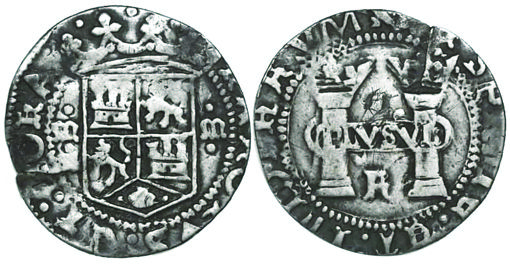
Early Series Assayer R 1 real (Sedwick auction #20, November 2016, lot 570)
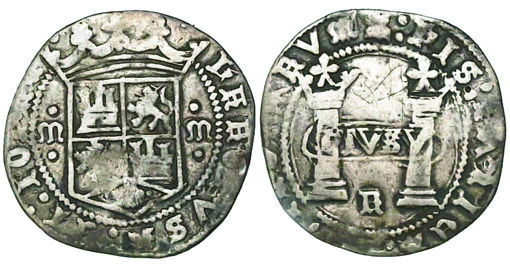
Early Series Assayer R 1 real (Sedwick auction #20, November 2016, lot 571)
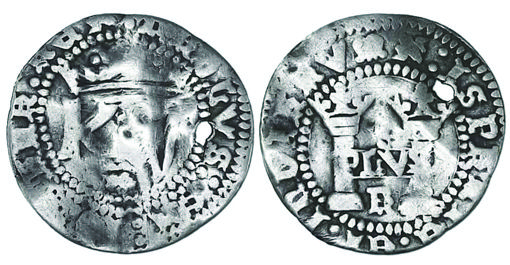
Early Series Assayer R ½ real (Sedwick auction #16, November 2014, lot 410)
According to royal decree the 1, 2, and 3 reales coins would have castles and lions with a pomegranate on one side and two columns with the inscription PLVS VLTRA on the other. The ½ real pieces would have a K (for Carolus or Charles, Joanna’s son and co-regent) and I (for Joanna). The legend on all the pieces would read CAROLVS ET IOANA REGES HISPANIE ET INDIARVM, meaning Charles and Joanna Rulers of Spain and the Indies, or whatever part could fit on the coins. The rest of the design was left up to the assayer.
Sometime in late 1537 or early 1538, 3 reales coins were discontinued in favor of 4 reales. This is why you do not see much Gothic lettering on the Assayer R 4 reales coins.
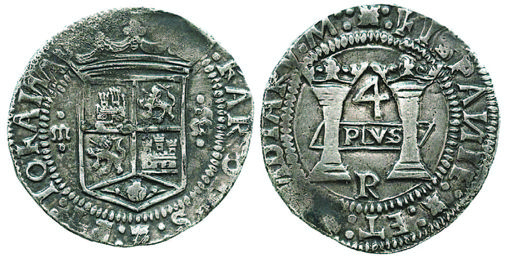
Early Series Assayer R 4 reales (Sedwick auction #12, October 2012, lot 891)
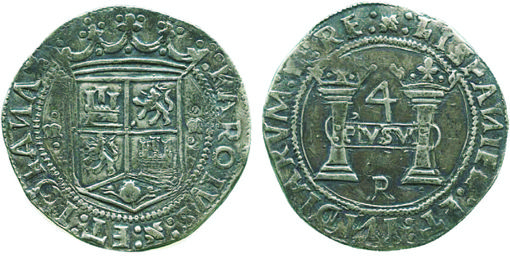
Early Series Assayer R 4 reales (Sedwick auction #13, May 2013, lot 932)
The punches wore out quickly and were replaced by crude or Latin punches which were probably easier to make and use. The 8 reales coins (of which only three are known) were produced at the same time as the 4 reales. Based on analysis of the lettering of the legends, the first issues from the mint were probably ¼, ½, 1 and 3 reales coins with the 2 reales coins appearing a little later. None of the coins are dated.
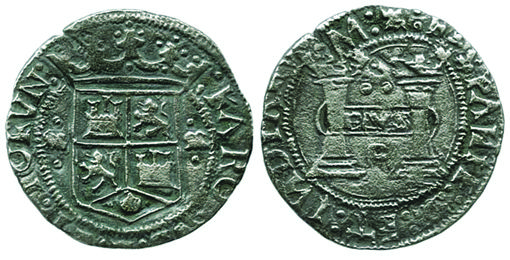
Early Series Assayer R 2 reales (Sedwick auction #7, April 2010, lot 176)
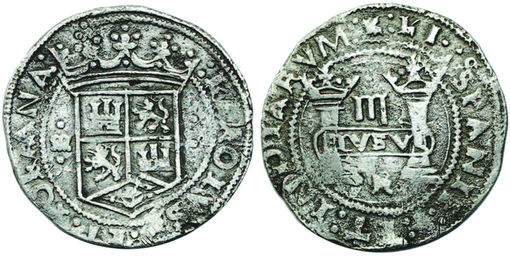
Early Series Assayer R 3 reales (Sedwick auction #14, October 2013, lot 615)
Early vs. Late Series Coins
Nesmith coined the terms “Early Series” and “Late Series” to differentiate two distinct periods of minting characterized by differences in design. Early Series coins were minted between 1536 and 1542 ending with Assayer G and Late Series coins from 1542 to 1571, beginning with the same Assayer G and ending with Assayer O. There were substantial design changes in 1542 when new dies arrived from Spain.
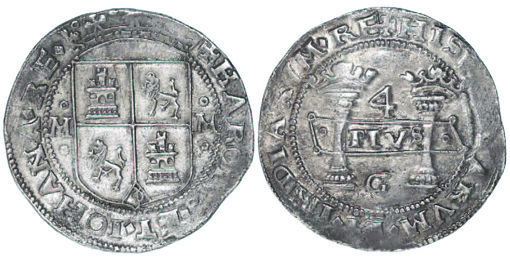
Early Series Assayer G 4 reales (Sedwick auction #19, May 2016, lot 604)
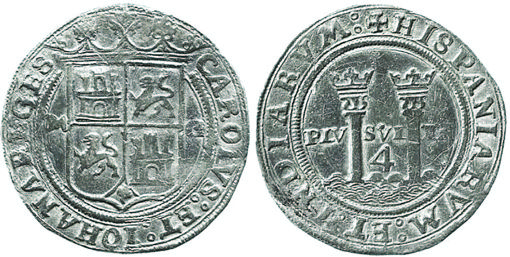
Late Series Assayer G 4 reales (Sedwick auction #12, October 2012, lot 908)
The major differences are
• Early Series coins generally did not have waves beneath the pillars (although a type of very early 3 reales coin minted under Assayer R has them).
• The spelling of Charles changed from KAROLVS in the Early Series to CHAROLVS and CAROLVS in the Late Series.
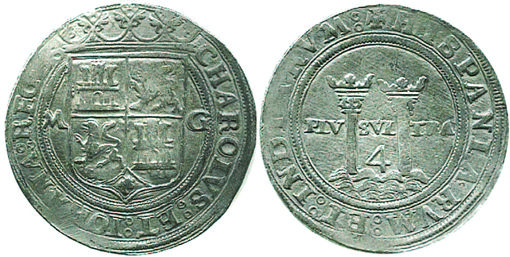
Late Series Assayer G 4 reales CHAROLUS (Sedwick auction #12, October 2012, lot 309)
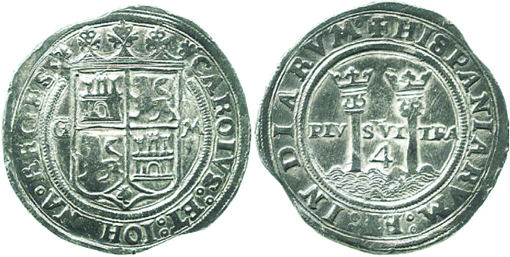
Late Series Assayer G 4 reales CAROLUS (Sedwick auction #12, October 2012, lot 906)
• PLVS or one of its derivatives for PLVS VLTRA appeared inside either a rounded or rhomboid banner between pillars in the Early Series and had no banner in the Late Series.
• Lettering in the legends went from Gothic to crude to Latin in the Early Series and all Latin (and more stylized) in the Late Series.
• Placement of denomination went from above the banner in the Early Series to below the banner in the Late Series.
• There was more standardization of design between assayers in the Late Series.
And by the way, Charles and Joanna coins from both periods tend to be much better struck and retain better detail than their successor, the cobs.
What is Rare?
Minor denominations (½ , 1, and 2 reales) are much harder to come by than 4 reales because shipwrecks mostly carried 4 reales coins and thus brought a lot of coins of that denomination to light since they were never purposely taken out of circulation.
¼ reales are extremely rare and you will probably never see one. Kent Ponterio created a census of them in which he cataloged
3 coins minted by Early Series Assayer R
3 coins minted by Early Series Assayer P
1 coin with an overassayer of Early Series F/P
3 coins minted by Late Series Assayer G
1 coin minted by Late Series Assayer S
The rarest assayers are F from the Early Series and S from the Late Series. I have cataloged only 36 Assayer F coins, in all denominations. Assayer S can be extremely rare, as in none known, in the ½ real and the 1 real with S-M. Otherwise, the other denominations and types come along from time to time.
